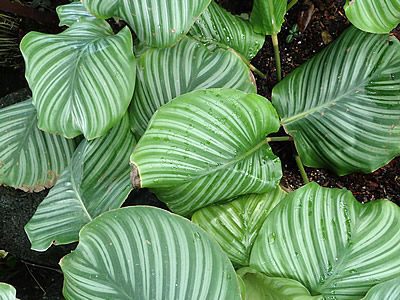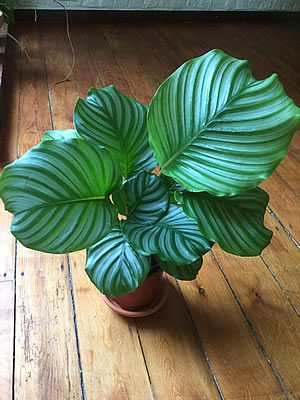The roundleaf calathea (Goeppertia orbifolia) is an herbaceous, rhizomatous, perennial species with large round and ornamental leaves. It is native to Brazil, specifically to the Atlantic Forest region. Its leaves are simple, alternate, petiolate, orbicular, coriaceous, shiny, light green in color, with dark veins and a green-grayish lower (abaxial) surface. There is also a variety with a purplish abaxial surface. The white inflorescences emerge close to the rhizome, are rare in cultivation, and hold little ornamental significance.
With beautiful shades of green and an intriguing striped pattern on its leaves, the roundleaf calathea is a stunning foliage plant to cultivate in well-lit indoor spaces. It has become one of the favorites of the Urban Jungle movement, which turns homes, apartments, shops, and offices into true havens of reconnection with nature. While it can be grown in pots and planters, some care is needed to keep the plant looking beautiful and healthy, as we will see below. Once you’ve mastered its care routine, it proves to be robust and low-maintenance, involving tasks such as removing old leaves and repotting every two years to change the substrate. In tropical climates, the roundleaf calathea can also be used as ground cover in semi-shaded areas, in woodland spaces, as well as in rows along corridors.

It should be cultivated in abundant filtered light or even with a gentle touch of morning sunlight. Intense sunlight from 9 to 17 hours can lead to leaf burns. The roundleaf calathea thrives in soil rich in organic matter, with good drainage and regular watering. As a species native to warm and humid forests, it does not tolerate intense cold, frost, or low relative humidity. Therefore, avoid cultivating this species in air-conditioned environments or areas with drafts. Enhance humidity indoors using humidifiers or by growing it alongside other plants that release plenty of moisture, such as ferns and maidenhairs. The ideal temperature range for growing the plant is between 18 and 24°C (64 to 75°F).
Similar to other marantas and calatheas, it’s recommended to water the plant with dechlorinated water, such as rainwater or water that has rested for a day and thus allowed the chlorine to evaporate. Allow the top layer of the substrate to dry between waterings. It doesn’t tolerate waterlogging, so always check if the pot is draining well and avoid using a saucer underneath. Fertilize during the growth period using organic and slow-release nutrient-rich fertilizers. In winter, suspend fertilization and reduce watering. Propagation is done through division of rooted clumps and, more rarely, through seeds.


